New Horizons Observes its First Object in the Kuiper Belt
NASA’s New Horizons spacecraft flew past Pluto last year to grab some incredible photographs of the planet and to study its atmosphere up close with the various sensors the spacecraft is equipped with.
But now that all that is said and done, NASA wants the New Horizons spacecraft to fly past a Kuiper Belt Object (KBO) known as KBO 2014 MU69 within 1900 miles, which is a very icy body that is only about 13-25 miles wide.
Since it’ll be a while before New Horizons gets there, NASA is already preparing for a post-Pluto mission for New Horizons by studying another closer KBO known as 1994 JR1, which is a 90-mile wide object that NASA says is 3 billion miles from the Sun.

At this distance, it is really hard, if not nearly impossible to study from here on Earth. We need powerful telescopes to peer that deep into space, and even then, there is hardly any light out there for us to see anything well enough.
For New Horizons on the other hand, which is already in 1994 JR1’s neighborhood, peering at it and sending us images is no contest at all.
Sure, it takes a little while for New Horizons to transmit that data back to Earth, considering it’s nearly 3 billion miles away, but eventually those signals reach us and we can learn more about the outskirts of our solar system.
The latest images, which were taken about 69 million miles away on April 7th and April 8th by New Horizon’s Long Range Reconnaissance Imager (LORRI), show 1994 JR1 in the clearest resolution images ever taken since November of 2015.
The images have allowed researchers to figure out how long a day is on 1994 JR1, as it takes about 5.47 hours for the object to complete a full rotation. NASA explains that this is a relatively fast rotation period for a KBO, and it is an interesting find because it changes the way we think about KBOs.
Future exploration in this territory may be revealing of some much-needed information about our solar system. It is hoped that NASA can grab some valuable details about the Kuiper Belt while New Horizons is out there.
Source: NASA








